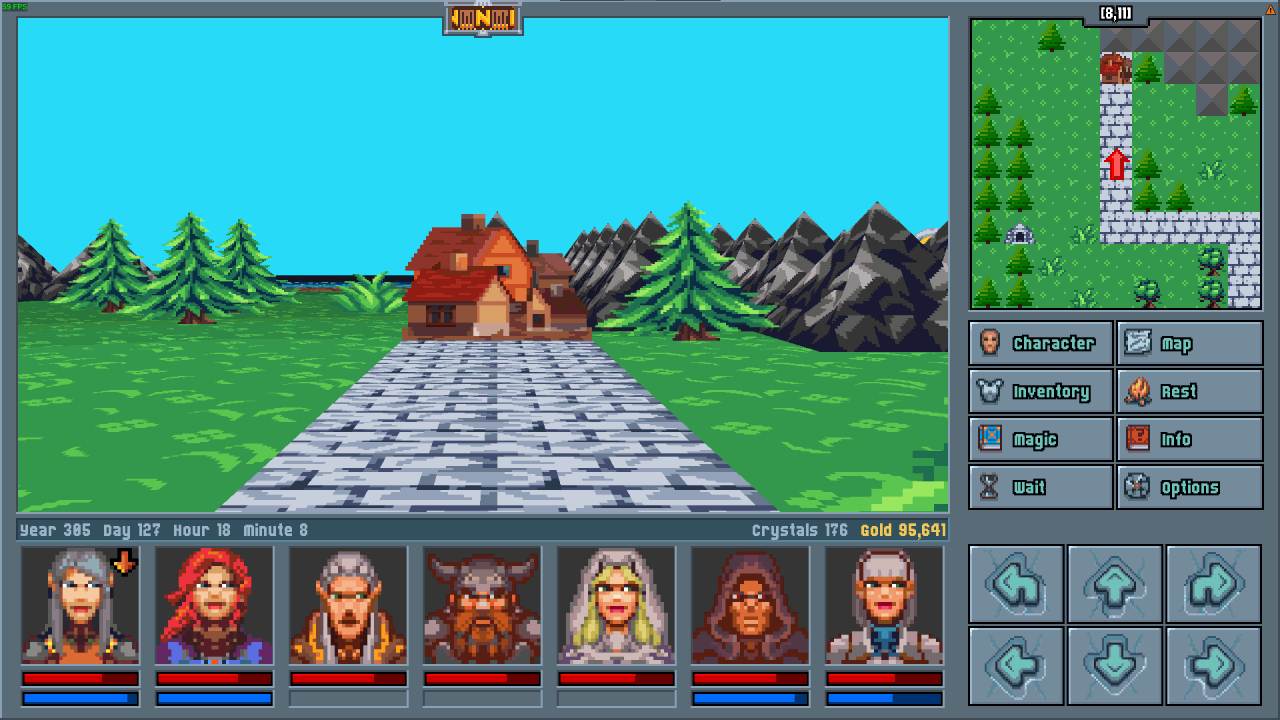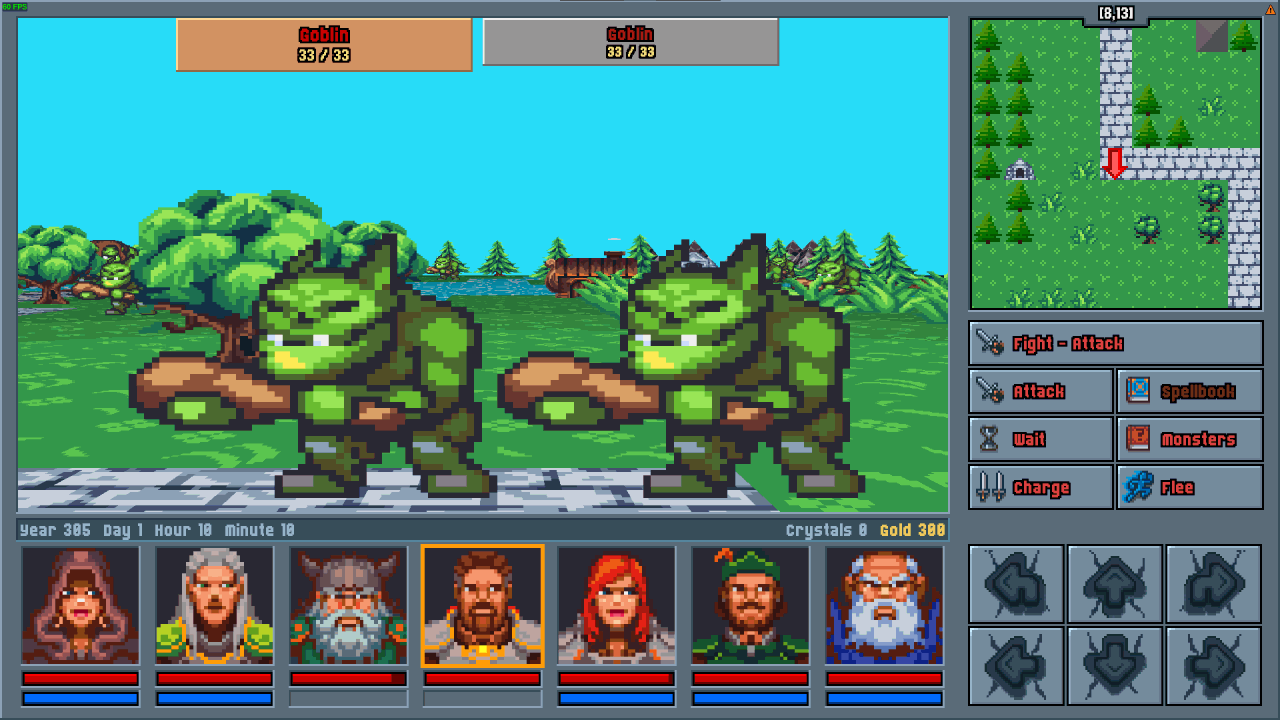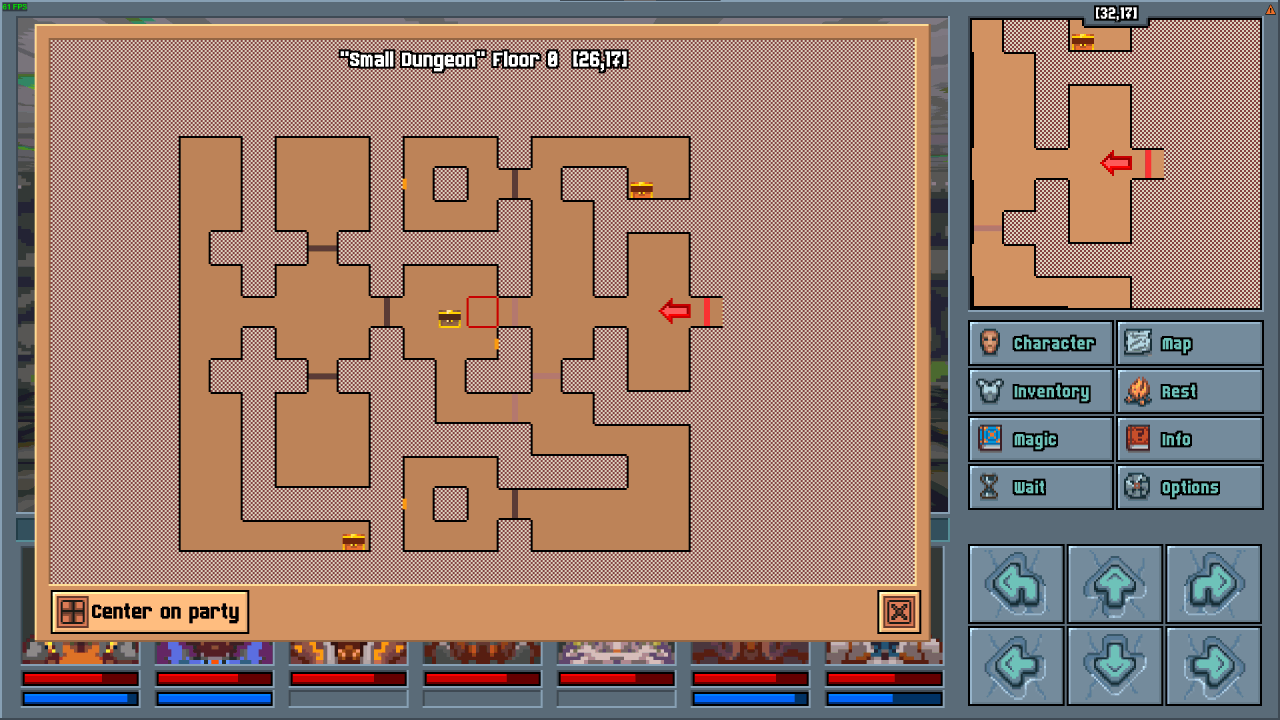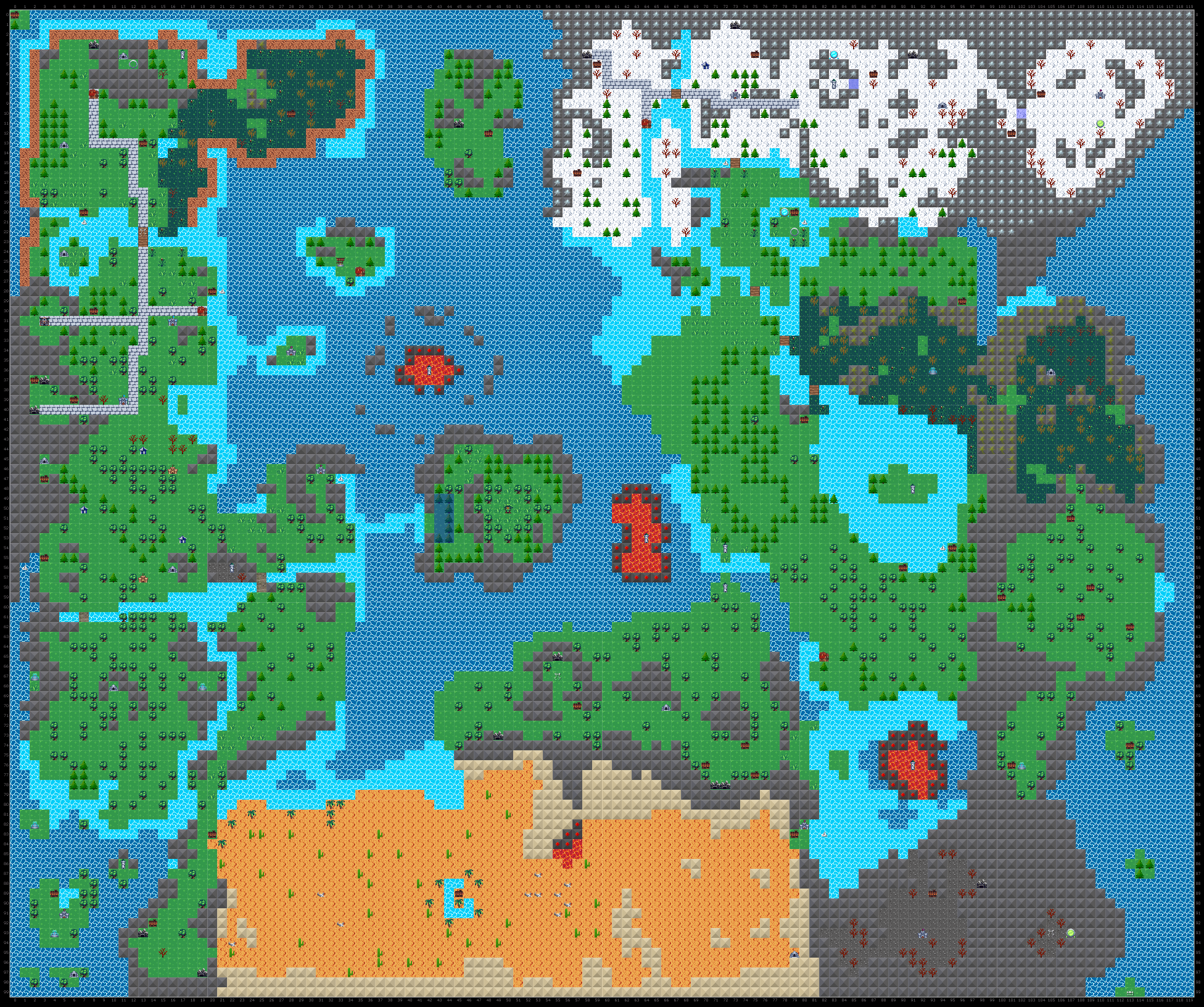2023-09-26: Legends of Amberland -- Might & Magic III-2
I bemoan somewhat regularly that I've mostly exhausted my supply of Might & Magic gridders to play. I still have Swords of Xeen, and I suppose Legacy exists (or does it? I don't know how the Ubisoft DRM debacle ended up). Aside from that though, not much. Wizardry and Beholder are the blobbers that get spiritual successors and homages and reboots, not Might & Magic. So when I discovered someone actually did make a spiritual successor to an early Might & Magic game, I took notice.
This is Legends of Amberland, a game that starts off looking and feeling like it mugged M&M3 in a back alley before diverging off on its own path somewhat. Amberland has all the trappings of M&M3: colorful oversaturated palettes, on-field enemies that move around when you do, zany sprited enemies and overblown combat sounds, "representative" dungeon layouts that look like what they're trying to be rather than tightly packed razor wall grids, and a plot that mainly consists of collect-a-thons disguised as quests.
In fact, in the first hours as I mapped the starting world (something I didn't have to do, since Amberland has an extremely competent automap), I started getting the feeling that the dev might have even copied the general shape of the Isles of Terra. This is a feeling that goes away once you get off the starting landmass, but it's powerful in its similarity to the west islands of Terra at the start.
Amberland does set itself apart in various important ways. The main way is instead of having gear limitations per class, Amberland introduces an encumbrance system. You have a limited number of weight points per character and armor takes varying amounts to wear. In essence this just re-establishes class limitations on gear as mages have 8-10 weight points and plate mail starts at 20, but you do get some wiggle room in the form of being able to wear a really good chain mail even on a mage, at the cost of not being able to wear any other gear.
Gear also feels slightly more "squished" in that instead of having a vast array of weapon types with their own hit dice, and tons of Diablo-style modifiers, gear in Amberland had three components: a weight cost, an armor value or damage multiplier, and 0 to 3 modifiers from a pool of about 15. The modifiers are extremely simple things like "Fire resistance" or "Enhanced critical chance", the damage multipliers range from 50% to 190% of your normal damage roll, rather than the weapon having hit dice on its own.
This results in a feeling of gear progression being extremely slow and horizontal. Most decent weapons have 140% damage multiplier and upgrades come in the form of better mods for each character's purpose. Most of your growth comes from levels.
The other major change is the quality of life of instant fast travel to any point on the world map you've been before. This must be unlocked via an early game quest, and there's an achievement for not using it, but really once you've been somewhere there's no point or challenge in being forced to walk there again by hand. This is strictly a plus in my book.
Amberland removes archery and ranged magic, requiring all battles to be fought in melee range. At first this decision chafed, but then I remembered garbage like the Annihilator Robots of Terra and the Cloud Dragons of Xeen. I think I prefer not having things that can blast me from six tiles away. Combat otherwise plays exactly like Terra with the exception of a change-up in how party order works. You have seven party members: the center three receive most of the hits and the flanking four are typically safe but go late in battle to compensate. This results in a practical guarantee that your mages and healers will act after the enemy has already acted, and that requires planning accordingly. No speedy mage nuking the field before anyone can act here.
Classes are arranged in a similar way to M&M3: you have your cores of knights and barbarians and thieves and priests and mages, then you have some weird hybrid classes like the ranger. Amberland throws in some racial-specific classes that try to tweak the formula of core classes: Dwarves get battlesmiths which are rangers more focused on offense and melee, Humans get champions which are fighters that get bonus damage to casters, Elves get mage knights which are essentially red mages. For the most part I didn't notice a big difference in how the tweaked classes operate.
The world and the plot are great throwbacks to M&M3 and feel almost exactly like something JVC would have written and designed. Amberland does fall short with its interiors, though: towns are simple menus rather than explorable zones, and dungeons lack any kind of secret doors or interactable widgets. Dungeons are simply just big mazes full of enemies, loot, and sometimes gates and switches. This leaves a feeling of 90% of dungeons being unimportant to explore, but you can get that same feeling from a proper M&M game too. M&M however had the benefit of puzzles and bashable doors and traps and similar features to keep dungeons somewhat fresh. Amberland has some of those, but they're used so sparingly they may as well not exist.
Amberland also has this weird quirk of doors being their own tiles. I never really liked that; it made mapping a pain. A personal quibble that is, though.
To enter spoiler territory, as I do with these write-ups: the plot of Amberland is fairly bare, even for a M&M style game. There's a crown that a royal wizard found tell of in an ancient tome, that seems important but no one knows anything about it. That's strange, so you're sent to try to figure out more about the crown. A short jaunt into talking to various NPCs to try to get more info, it's revealed the likely reason the crown is forgotten is someone hid it and cast a spell to shroud its memories from the minds of the people. You're then sent on a quest to find three magic orbs to power the spell to break the curse and let everyone remember where the crown might be. It's an odd one for sure.
Each of the three orbs is a microcosm if an entire Might and Magic macguffin hunt:
- The Red orb requires you find six chunks of Adamantite in various caves to make a pickaxe to dig it out
- The Blue orb requires you find ten bags of magic dust from faeries trapped in evil wizard lairs
- The Green orb requires you get a blessing from one of two sages via either finding five flowers from side-quests to three obsidian rings from dungeons
Oddly, splitting the macguffin hunt like this makes it feel more contrived and tedious. In M&M 3 thru 5 you had to find about as many macguffins of varying types, but it was one type of thing for each game: a bunch of orbs of power, kingdom coins, energy discs... Having one type felt like tangible progress toward a singular plot goal with each dungeon you cleared. Having this tree of things to hunt left a feeling of not knowing how many layers deep the tree went. Fortunately the orbs are it; once you have them you begin the endgame.
The endgame sends you to a sealed tower near the start of the game, getting you access to it via talking to four wizards spread across the world, entering, defeating an evil wizard inside, and getting a component that powers a portal to the final boss and the crown. Returning the crown to the king ends the game.
So the victory path for this one...
- Talk to the Royal Wizard
- Get sent back and forth between two researchers until they explain you need the three orbs
- Get strong enough to cross the desert to the south, which will open up the entire world to you
- Perform the task of either the North Sage or the South Sage to get a pass into the kingdom's library
- Read about how to cross the Enchanted Forest, within which is the Green Orb
- Gather six hunks of Adamantite from various mines around the world
- Retrieve a dwarven blacksmith's anvil from the Goblin Dungeon
- Smith an Adamantite Pickaxe
- Take the pickaxe to a miner near the desert to have him dig out the Red Orb
- Find ten bags of magic dust in various "magical" dungeons
- Enter the Tower of Northern Winds, defeat the evil wizard inside
- Give the dust to the North Wind Sage to get the Blue Orb
- Give the three orbs to the Royal Wizard, get sent to four wizards across the world to get access to the Ivory Tower
- Enter the tower, defeat the insane wizard at the top, get the Portal Component
- Give the Portal Component to a hermit near a dead portal, fixing it and giving access to the final boss and crown
Most of this boils down to "Explore all the dungeons and get the stuff along the way" as is the case with most M&M games. The journey is the destination and whatnot. There's a wealth of sidequests but almost all of them consist of an NPC immediately near a dungeon asking you to clear that dungeon for a reward. This is where things can be a little repetitive and samey. I mostly kept things interesting by mapping everything, as I enjoy mapping.
Even 100%ing the game, mapping everything by hand, I finished in about 20 hours. It'd be far less if you just took notes and used the automap. The game is pretty easy, though it has difficulty modes to let you spice things up if you feel it's too easy. I probably should have played on a higher difficulty, especially given I accidentally defeated a super boss before even realizing it was a super boss. There's three of those in the world: three differently colored dragons that have far more health than anything else in the game, located in out of the way optional locations.
In truth, the big difficulty spike is the desert: a stretch of barren, enemy-filled nothing across the bottom of the world. Crossing it requires being able to handle the powerful scorpions and snakes running all around it. Once you do, you find a ship moored to the eastern coast of this continent, and gain full world access from there. Oddly, most of the places you can now go have foes far weaker than what you just fought to get there. Some dungeons have equally strong or stronger foes, but the wealth of options you have ensures you're more than strong enough to take any obstacle before you as long as you do things in roughly the right order.
Amberland also has the quirk of enemies don't respawn. Once you kill everything in the world that's it, no more combat, no more experience. This will place you around level 55 depending on difficulty and what races your party members are: elves require more experience to level. On one hand it's neat to be able to just completely clear an area, or even the entire world, like that. On the other hand it feels a little strange knowing there's a hard cap on how much experience you can get, especially since dying in combat means you don't get any for that battle. Level 55 is more than strong enough to finish the game, though. Even level 40 would be fine.
Though, as I did with M&M 1 thru 5, I did painstakingly map 100% of the overworld; can't miss that...
Quibbles aside, Legends of Amberland is the closest thing to a new classic Might & Magic I've had since I finished Worlds of Xeen. That alone makes it a 5 out of 5 in my book. It's a strong homage and spiritual successor to Isles of Terra, and with a sequel on the horizon I'm looking forward to even better things from the dev.
tags: game_writeup, rpg, amberland, might_and_magic





